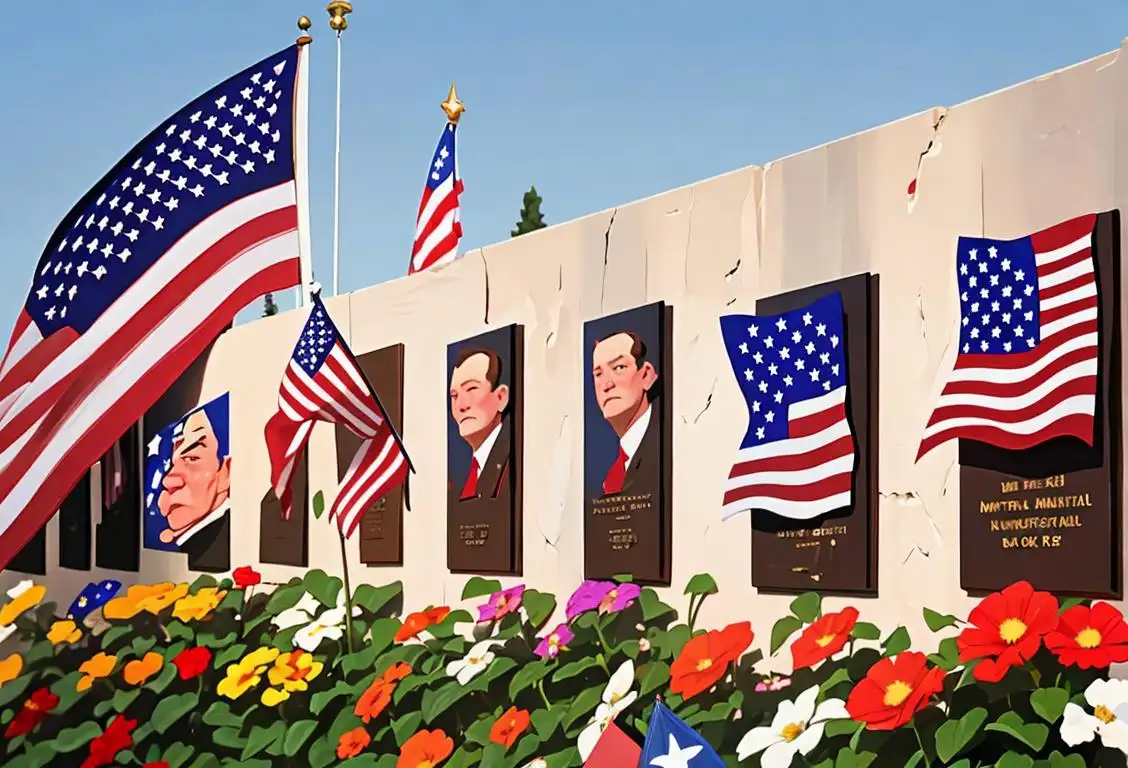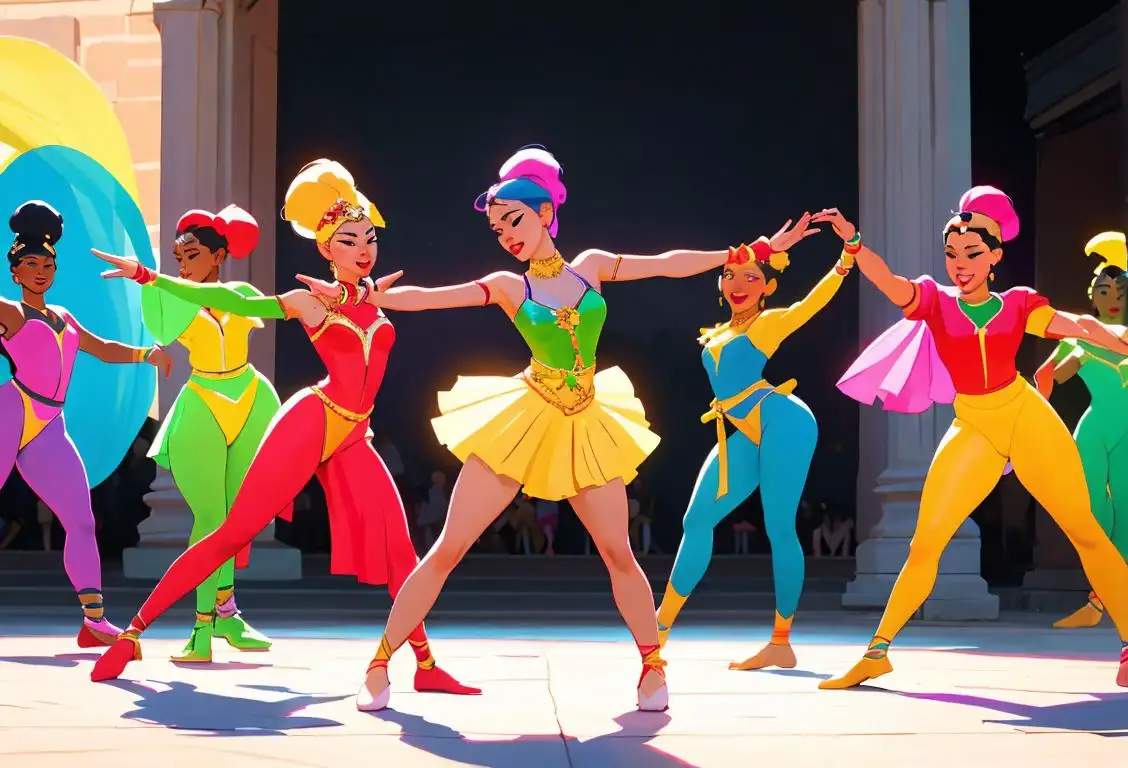National Freeball Day

Welcome to the world of National Freeball Day! Get ready to shed those constricting undergarments and let it all hang loose. This unique holiday is all about embracing freedom and letting everything breathe. Whether you're a fan of going commando or simply curious about this liberating practice, National Freeball Day celebrates the carefree spirit that comes with leaving the undies behind.
When is Freeball Day?
It's national freeball day on the 16th October.
The Origins of National Freeball Day
Have you ever wondered who came up with the idea of going freeball? Well, you're not alone! The origins of National Freeball Day can be traced back to the early days of the internet, when a group of friends decided to start a movement that celebrated the joy of going underwear-free. Their mission was simple: to promote a sense of freedom and comfort by encouraging people to ditch their undergarments, if only for a day.
Word spread quickly, and soon the idea took off like wildfire. People from all over the world embraced National Freeball Day with enthusiasm, eager to experience the liberation that comes with letting it all hang out. Social media platforms played a key role in spreading the message, with hashtags like #FreeballNation and #CommandoLife gaining popularity.
While some may see National Freeball Day as a lighthearted and fun holiday, it also serves as a reminder to break free from societal norms and expectations. It's about embracing your body and feeling comfortable in your own skin. So, if you've always wanted to try going commando but were too afraid to take the plunge, this is the perfect opportunity to give it a shot!
Celebrating National Freeball Day
Now that you know the origins of National Freeball Day, let's talk about how you can celebrate this unique holiday. Here are a few ideas to get you started:
1. Embrace the Breeze
Take this day as a chance to experience the freedom of going underwear-free. Whether you're lounging at home or going about your daily activities, let the breeze brush against your unencumbered nether regions and revel in the freedom!
2. Support Freeball-Friendly Brands
While going commando is all about freedom, it's essential to wear clothing that is comfortable and supportive. Look for brands that cater to the freeball lifestyle and invest in underwear alternatives that provide the perfect fit without the need for traditional undergarments.
3. Spread the Word
Share the joy of National Freeball Day with your friends and loved ones. Use social media platforms to spread awareness and encourage others to give going commando a try. Who knows, you might inspire someone to embrace the freedom, too!
History behind the term 'Freeball'
1967
The Invention of the Term
The term 'freeball' was first coined in 1967 and quickly gained popularity among college students in the United States. It referred to the act of not wearing underwear beneath one's clothing, particularly among men. 'Freeball' became a playful and somewhat rebellious way to embrace comfort and freedom, rejecting traditional underwear norms.
1940s
The Birth of Boxer Shorts
In the 1940s, a new style of men's underwear emerged: boxer shorts. Unlike traditional briefs, boxer shorts were loose-fitting and provided more freedom of movement. This style became popular and was commonly worn by men who sought comfort and breathability.
1973
The invention of the term 'freeball'
In 1973, the term 'freeball' was coined as a colloquial term to describe the act of not wearing underwear under one's clothing. It is believed to have originated from the combination of the words 'free' and 'ball', referring to a sense of liberation and freedom from the confinement of undergarments.
1962
The introduction of women's pants.
In 1962, women's fashion took a bold step forward with the introduction of pants designed specifically for women. This marked a significant departure from the traditional skirts and dresses women had been wearing for centuries. The newfound freedom and comfort provided by pants laid the groundwork for the term 'freeball' to emerge.
1947
The Birth of Boxer Shorts
In 1947, the first commercially available boxer shorts were introduced by Jacob Golomb, founder of sports apparel company Everlast. These loose-fitting, knee-length shorts became popular among athletes, providing them with comfort and mobility. The term 'freeball' had not yet come into existence.
1890
The Athletic Evolution
In the late 19th century, sports became increasingly popular, particularly among men. As athletic activities such as baseball, football, and tennis gained recognition, men started seeking more comfort during physical exertion. This led to the development of looser and more flexible clothing, including the introduction of underwear with a less restrictive design.
1879
The Origin
The term 'freeball' originated in 1879 when baseball players began playing the sport without wearing any underwear or protective cups. This was mainly done to increase comfort and mobility during the game. Players believed that going commando allowed them to move more freely and not be hindered by restrictive clothing. It quickly became a popular practice among professional baseball players.
1920
The Birth of 'Freeball'
The term 'freeball' originated in the 1920s in American baseball. It referred to a situation in which the ball was hit hard and cleanly enough that it reached the outfield without touching the ground or being caught by a fielder. This play was considered remarkable and exciting, leading players and fans to describe it as a 'freeball.' The term quickly gained popularity within the baseball community.
1950
The birth of the term
The term 'freeball' first emerged in the 1950s and is believed to originate from American prison slang. In this context, it referred to the practice of prisoners not wearing underwear or going without a supportive undergarment. It was seen as an act of rebellion or defiance against the prison system's regulations.
1969
The invention of the term 'freeball'
In 1969, the term 'freeball' was first coined. The term is derived from the phrase 'free balling,' which refers to not wearing underwear under one's pants. It originated from the idea of feeling 'free' and unrestricted in one's clothing choices.
1970
Popularization through counterculture movements
During the 1970s, counterculture movements, such as the hippie movement, embraced a non-conformist philosophy. The idea of 'freeballing' became popularized among individuals who rejected societal norms and sought freedom in various aspects of their lives, including clothing choices. 'Freeball' became a slang term used to describe this practice.
1960s
The Commando Mentality
During the counterculture movement of the 1960s, many individuals began challenging societal norms. This rebellious mindset extended to clothing choices, including underwear. Some individuals, particularly among the hippie and free-spirited communities, embraced the idea of going commando—i.e., not wearing any underwear under their garments. This practice symbolized a rejection of conventional fashion and societal expectations.
1920
Spreading through Baseball
During the 1920s, the practice of going 'freeball' spread beyond just baseball players. Athletes in other sports, such as football and basketball, also adopted this practice. They believed that by eliminating the need for underwear or protective cups, they could enhance their performance on the field. The term 'freeball' became synonymous with this practice and was widely used within the sporting community.
1970
The emergence of unlined trousers.
Throughout the 1970s, the fashion industry saw a rise in the popularity of unlined trousers. These pants often lacked the additional layer of fabric that traditionally served as underwear. As a result, some individuals began to go commando, opting to forgo wearing traditional underwear altogether. This practice, along with the newfound liberation of women's pants, contributed to the cultural understanding of 'freeballing'.
1970
The Rise of Counter-Culture
As the counter-culture movement gained traction in the early 1970s, 'freeballing' became associated with a certain level of nonconformity. It was seen as a symbol of rejecting mainstream societal expectations and embracing a more liberated lifestyle. The idea of going 'commando' gained popularity as a way to break free from restrictive norms and challenge conventional ideas of modesty.
1960
Expansion to Other Sports
In the 1960s, the term 'freeball' started to expand beyond baseball and found its way into other sports, particularly basketball. In basketball, 'freeball' referred to a situation in which a player took a shot without the ball touching the rim or backboard. It became synonymous with a clean, swish shot and was often used to describe skilled shooting. As the term gained traction among basketball players and commentators, it also began to be used more broadly in the sporting world.
1935
An Unconventional Approach
One of the first notable mentions of the term 'freeball' can be traced back to the mid-1930s. During this time, a renowned German naturalist named Richard Hesse wrote a book called 'Richtig leben, Richtig lieben' (Living Right, Loving Right). Hesse advocated for a healthier lifestyle, which included unconventional ideas about clothing freedom. He encouraged men to abandon traditional undergarments to experience a greater sense of liberation, both physically and psychologically.
1960
The Rise of Going Commando
During the 1960s, the counterculture movement gained momentum, challenging societal norms and embracing individual freedom. As part of this cultural shift, people began to reject traditional undergarments like boxer shorts and opted to 'go commando', meaning to wear no underwear at all. This practice gained popularity among those seeking a sense of liberation and comfort.
1980
Popularity among athletes amplifies the term
By the 1980s, the term 'freeball' gained popularity primarily among male athletes who preferred the freedom and comfort of going commando while participating in sports activities. Athletes, particularly in contact sports like football, found that wearing tight undergarments restricted their movements and hindered their performance. As a result, 'freeballing' became an informal practice embraced by many athletes.
1970
The transition to the mainstream
Throughout the 1970s, the term 'freeball' gradually made its way into the mainstream culture. It started being used by non-prisoners to describe the act of not wearing underwear, either intentionally or out of forgetfulness. This shift in meaning expanded its usage beyond the prison context.
1970s
Going Freeball in Disco
The 1970s disco era boosted the popularity of going freeball. Tight-fitting disco pants and flashy costumes necessitated a smooth, seamless silhouette. Consequently, many disco-goers chose to ditch their undergarments, providing a more streamlined look and unrestricted dance moves on the dance floor.
1980
A Fashion Trend
During the 1980s, 'freeballing' transitioned from a rebellious act to a fashion trend. Many fashion designers and brands started designing pants and shorts with looser and more comfortable fits, encouraging the freedom of movement without the need for underwear. Influential figures in popular culture, such as musicians and actors, further popularized the notion of 'freeballing' as a stylish and carefree choice.
1990
The normalization of commando
During the 1990s, the term 'freeball' became synonymous with 'going commando' in many English-speaking countries. 'Going commando' refers to the practice of not wearing underwear intentionally, often as a personal preference or for comfort. It gained popularity as a fashion trend and was seen as a liberating choice for both men and women.
1990
Adoption by popular culture
During the 1990s, the term 'freeball' started to make its way into popular culture. It became a source of humor and fascination in movies, TV shows, and music. The concept was often portrayed in comedic or risqué contexts, contributing to its recognition and association with rebelliousness and non-conformity.
1990
Transition to a Colloquial Phrase
By the 1990s, 'freeball' had transitioned from being primarily a sports term to a colloquial phrase used in everyday conversations. It took on a new meaning and was used to describe a situation in which someone was not wearing underwear beneath their pants or shorts. The term gained popularity as a slang expression, often associated with a sense of freedom, comfort, or rebellion. The use of 'freeball' in this context became prevalent in various subcultures and even infiltrated popular culture.
1960
Cultural Impact
In the 1960s, 'freeball' extended beyond the realm of sports and started to make its way into mainstream culture. As a symbol of freedom and rebellion against societal norms, going 'freeball' became associated with counterculture and the hippie movement. The term was often used to describe individuals who rejected traditional conventions and embraced a more unconventional lifestyle. 'Freeballing' became a symbol of liberation and self-expression.
1980s
Integration into popular culture
By the 1980s, the term 'freeball' had made its way into mainstream popular culture. It was often portrayed in movies, television shows, and music, further solidifying its association with a carefree and rebellious lifestyle. The term gained a broader recognition and became a symbol of individualism and independence.
1970
The Counter-Cultural Movement
The 1970s witnessed a surge in countercultural movements that challenged societal norms, including the way people dressed. This era saw the rise of the 'hippie' culture and the popularization of naturalism and anti-establishment ideologies. In line with this sentiment, many men began embracing 'freeballing' as a form of expression and rebellion against traditional dress codes.
1985
The rise of men's skinny jeans.
In the mid-1980s, men's fashion took a turn towards tighter-fitting clothing. Skinny jeans gained popularity among young men, and this trend also played a role in the development of the term 'freeball'. The snug fit of these pants made traditional boxers or briefs more likely to cause discomfort and visible lines. As a result, some men opted to free their nether regions from the constraints of underwear while wearing skinny jeans.
1973
The Emergence of the Term 'Freeball'
In 1973, the term 'freeball' emerged as slang to describe the act of not wearing underwear, particularly with regards to men. The term referenced the freedom and ease that came with going commando. It quickly became popularized, being used in casual conversations and even finding its way into movies and music.
2010
Integration into Urban Dictionary
In the 2010s, the term 'freeball' found its way into the online platform Urban Dictionary, which documents slang and colloquial language. It was listed with the definition related to not wearing underwear beneath pants. This solidified its position as a recognized term within contemporary slang. 'Freeball' continued to gain popularity, fueling discussions and debates about clothing choices and comfort. It remains a part of modern colloquial language, known for its multifaceted origins and varied interpretations.
1990
The coining of the term 'freeball'.
During the 1990s, the term 'freeball' emerged in popular culture. It became a colloquial expression used to describe the act of not wearing underwear, especially in the context of loose-fitting or unlined pants. The term gained traction, particularly among younger generations, and further solidified the concept of freeing oneself from the confines of traditional undergarments.
1990s
Normalization through fashion trends
In the 1990s, fashion trends underwent significant changes. Baggy pants and loose-fitting clothing became increasingly popular. This trend coincided with the concept of 'freeballing,' as many individuals found it more comfortable to forgo underwear when wearing such clothing styles. 'Freeball' became a term commonly used in fashion circles to describe this practice.
1990
Controversies and Health Concerns
In the 1990s, the practice of 'freeballing' faced some controversies and health concerns. Some experts argued that not wearing underwear could increase the risk of certain infections or chafing. However, these concerns did not significantly dampen the popularity of the term or the act, as many individuals continued to embrace the comfort and liberation it offered.
1980
Sitcom and Pop Culture Exposure
The 1980s brought the topic of 'freeballing' into popular culture with the emergence of sitcoms like 'Married... with Children.' The character Al Bundy, played by Ed O'Neill, was often depicted as a stereotypical 'everyman' who would lounge around the house in his underwear, embracing an informal and relaxed way of dressing. This portrayal contributed to the normalization and acceptance of 'freeballing' as a casual lifestyle choice.
2000
Freedom of expression movement
In the early 2000s, the term 'freeball' found itself associated with the broader notion of freedom of expression. It became a symbol of breaking societal norms and embracing individuality. This movement was fueled by various subcultures and communities that embraced alternative fashion styles, including minimalistic or non-traditional clothing choices.
2000
Freeballing in popular culture
In the early 2000s, the term 'freeball' started to appear more frequently in popular culture, especially in movies, TV shows, and music. It became a common topic of humor and innuendo, often associated with the carefree and rebellious attitudes of characters. This contributed to further spreading the term's usage and familiarity.
1990s
Single-Layer Fashion Trend
In the 1990s, fashion embraced minimalism and simplicity. This trend influenced not only outerwear but also undergarments. Many designers started creating pants and shorts with built-in liners, reducing the necessity for traditional underwear. As a result, some individuals opted to freeball, wearing these single-layer garments without any additional layers.
1980
Fashion Statement
In the 1980s, 'freeball' took on a new meaning in the fashion industry. The idea of going without underwear became a fashion statement, particularly in the realm of men's fashion. Designers showcased various styles of pants and jeans that were specifically designed to be worn without underwear, giving rise to the term 'freeballing' in the fashion world. It became a trend that represented a bold and confident attitude.
1990
The Popularity in Pop Culture
By the 1990s, 'freeball' had firmly embedded itself in pop culture. It appeared in various movies, television shows, and songs, often referencing the act of not wearing underwear. This cultural prominence helped to solidify the term's association with a relaxed, carefree attitude towards undergarments.
Present
Continued Usage
Today, the term 'freeball' is still used to describe the act of not wearing underwear. While it may have originated in the world of sports, it has now become a part of everyday language. Whether for comfort, fashion, or personal preference, many individuals choose to go 'freeball' as a way to embrace a more relaxed and liberating lifestyle. The term continues to evolve and adapt to different contexts.
Present
Embracing personal choice
Today, the term 'freeball' has become widely known and accepted as a casual slang term for not wearing underwear. It represents a personal choice based on comfort, convenience, or fashion preference. While still maintaining a playful connotation, 'freeball' has lost much of its controversial edge and has become a term that celebrates individual freedom and expression.
Present
Continued usage and cultural impact.
Today, the term 'freeball' continues to be used to describe the act of not wearing underwear. It has become more widely accepted and is often associated with comfort, liberation, and non-conformity. While personal preferences regarding underwear choices vary, the term 'freeball' represents a cultural shift in the way we approach undergarments and embrace personal freedom in fashion choices.
Present
Modern Acceptance and Varied Interpretations
In the present day, 'freeball' continues to hold relevance in cultural discussions about undergarments and personal freedom. The term has evolved to encompass different interpretations, including the idea of wearing loose-fitting underwear or simply embracing a nonconformist mindset. While its usage varies, 'freeball' remains a part of popular vocabulary, reflecting society's ongoing exploration of comfort, choice, and self-expression.
Present
Continued usage and influence
Today, the term 'freeball' remains a part of contemporary slang and is used both seriously and humorously to refer to the act of going without underwear. It symbolizes a sense of liberation and non-conformity, while also representing comfort and personal preference. While the practice is not universal, 'freeball' continues to captivate popular culture and remains an intriguing part of societal discourse.
Present
Continued usage and modern connotations
Today, the term 'freeball' is still in use and has evolved to encompass a broader meaning. While its original association with not wearing underwear remains, 'freeball' can also refer to a mindset of spontaneity, freedom, and breaking away from societal constraints. Whether used in discussions about clothing choices or as a metaphorical expression, 'freeball' continues to be a term that captures the desire for liberation and individuality.
2000
Internet and Online Forums
With the advent of the internet, 'freeballing' found a new platform for discussion and community building. Online forums and chat groups dedicated to men's fashion and lifestyle choices provided a space for individuals to share their experiences and preferences regarding 'freeballing.' This enabled the term to gain further prominence and expand its reach among like-minded individuals.
Present
Continued Popularity and Evolving Perspectives
Today, 'freeballing' remains a term commonly used to describe the act of not wearing underwear. It has evolved to be more inclusive of all genders and is not limited to specific subcultures. While some still view it as a rebellious or provocative choice, others simply see it as a matter of personal comfort and preference. As fashion continues to evolve, the concept of 'freeballing' may adapt alongside it, taking on new meanings and interpretations.
Present Day
A Personal Preference
Today, freeballing is viewed as a personal preference rather than a widespread fashion trend. Some individuals choose to go commando for comfort, breathability, or simply because they find it liberating. Others still prefer traditional underwear for support or personal reasons. The term 'freeball' now serves as a casual slang term referring to the act of not wearing underwear, regardless of the motivations behind it.
Present
Continued Cultural Significance
Today, 'freeballing' remains a relevant concept within discussions surrounding comfort, personal freedom, and clothing preferences. While it may still be considered unconventional by some, it has become part of the larger conversation about body positivity, individuality, and breaking away from societal expectations. The term has evolved from its humble origins, transcending sports and counterculture, to become a symbol of self-expression and a personal fashion choice for those who embrace it.
Did you know?
Did you know that going commando has some potential health benefits? By allowing more airflow in the nether regions, it can help prevent certain infections and promote better genital health. Just remember to practice good hygiene, folks!Tagged
awareness funFirst identified
16th October 2015Most mentioned on
16th October 2015Total mentions
4Other days
Nurses Day
Former Prisoner Of War Recognition Day
Press Day
Handloom Day
Heroes Day
Memorial Day
Dance Day
Bestfriends Day
Liberation Day
Love Your Pet Day









